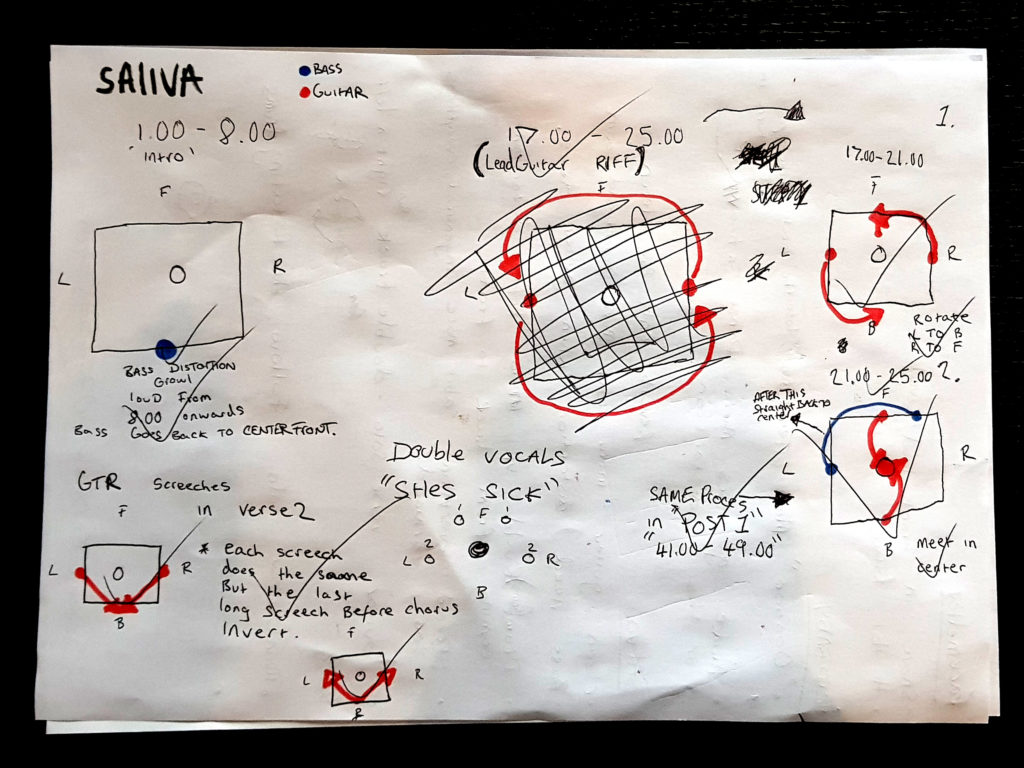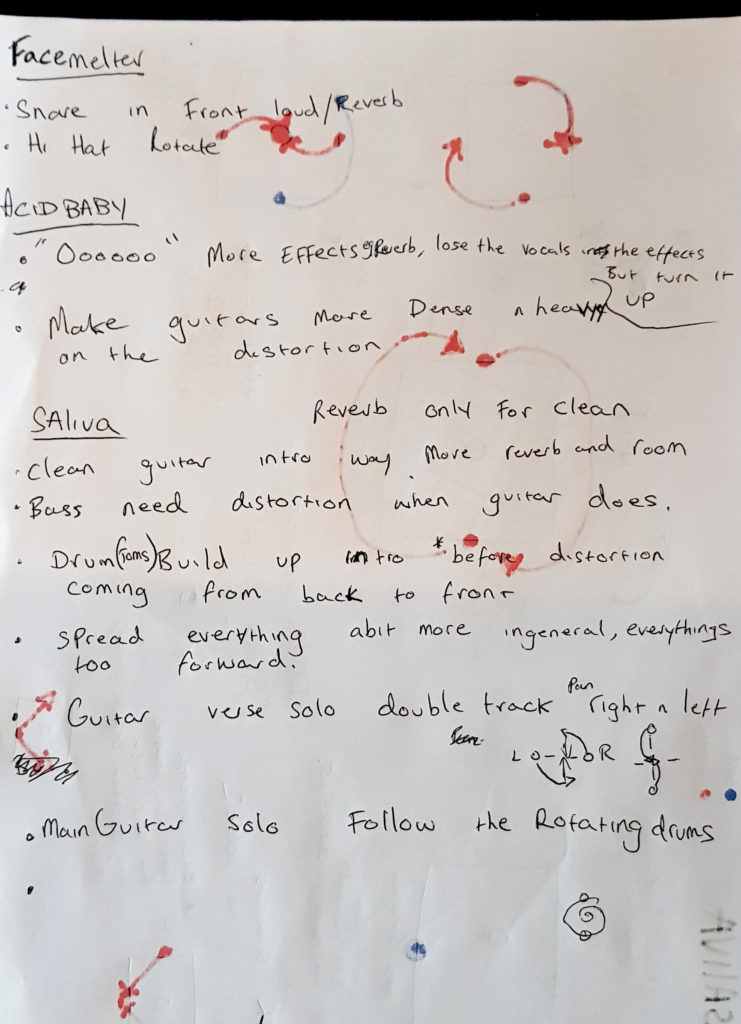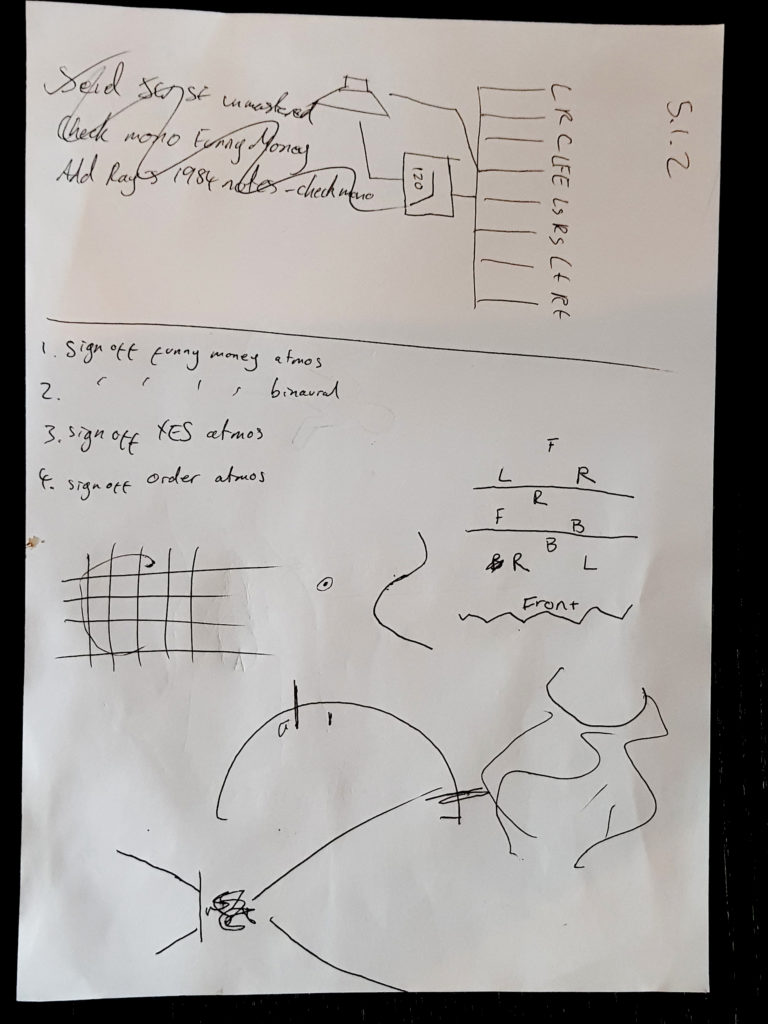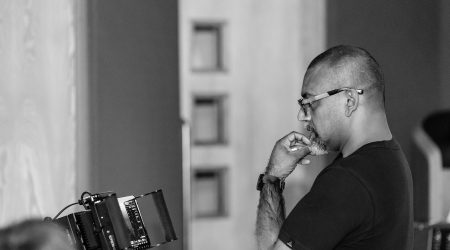[11 Nov 2019]
Jacaranda’s immersive engineering team, James Kershaw & Jamie Barker, throw light on their experiences working with Artists to give their music the 3D Audio treatment.
Q: How do you take an artist’s work, and make it better? Not better in terms of musicality, style or content, but bigger, richer, and deeper?
A: Use immersive audio technology to boost their work using a wider, more versatile palette.
In theory at least, the technical process for taking stems produced in a traditional studio setup is relatively straightforward:
An immersive audio mixing project usually begins with the spatial engineer receiving the individual parts of a completed stereo mix, or “stems”. Starting with the stems panned into the left and right channels, creating a mix that is as close as possible to the stereo mix, the immersive audio engineer will start to pan individual sounds around the room. These sounds can be placed beside, behind and above the listener, creating a more enveloping presentation of the stereo mix.
Easy – but only if you remember that the artist, together with the producer and/or engineers of a recording project, is likely to have put a considerable amount of time and effort into perfecting the stereo mix. If you know what you’re about, you’ll honour these decisions during the initial remixing session, as any significant changes are odds-on to stoke creative tensions from the beginning.
This is why the first mix is likely to be relatively conservative, with sounds spread evenly around the room rather than flying in different directions. Dynamic panning (when sounds appear to move & spin around) takes time to apply to the mix, and this is often where the artist will be wanting to put their stamp on the mix.
A considered approach to dynamic panning versus static panning is the key to striking the balance between a safe mix (which sounds too similar to the stereo) and a distracting mix (one where dynamic panning is overused). In our experience, the artist tends to push for more intense movement, so it is the engineer’s job to help them sift through their ideas and figure out which might work – and to what extent.



When working with SPILT on their recent EP, SICKLY FIT, and album, NO BALL GAMES, this was taken to an extreme. We found ourselves trying to keep up with a group of musicians overflowing with ideas. On average, in the time it took to draw in one of the very specific patterns they were asking for, the band had already offered up three more – on different instruments, sections, or even both!
NO BALL GAMES is full of sound effects, some created with guitars, some with vocals and some you’d expect from a film soundtrack (particularly YES, ORDER, and SOMEONE N NO-ONE). All of these sounds lend themselves to dynamic panning… but all at the same time? The biggest challenge doing these mixes was to get as many of the band’s ideas down as possible while trying to keep the mix intact, but SPILT are masters of spinning chaos and confusion into threads of gold …
As the project progressed, so did their understanding of the strengths of immersive audio technology. The band quickly began to get to grips with it, and started making effective decisions that ultimately led to the tracks being much more immersive than if they’d been mixed by an engineer alone.
While SPILT’s debut immersive album launched countless sounds effects at the listener, everyone was launched with coherent intent. Dynamic panning was used more to highlight a change of section and done with more predictable and repeated movements that enhanced the tensions and resolutions of the music.



Binaural Stereo
A Dolby Atmos mix is all very well, and it will give listeners an immersive experience when played back on an appropriate system, but neglecting the increasing number of people that listen exclusively on headphones (the almost silent majority) would mean missing out on the largest sector of the music market.
Binaural audio allows us to simulate the sensation of sounds being placed around, above and below the listener in the same 2-channel (stereo) format as any other music file. Done well, a binaural mix will give the listener a significantly more immersive experience than a standard stereo mix.
A binaural stereo mix can be automatically created from a full Dolby Atmos mix, though there are some creative mixing techniques that cannot be used, due to the topology of the mixing and rendering software. It therefore makes more sense to make a duplicate of the mix and approach it like a stereo mix, using binaural stereo panners (we used Sennheiser’s Ambeo Orbit plug-in on SPILT sessions).
Working with SHARDS on REFRACTIONS EP, the focus was on translating the Atmos to a binaural headphone mix. With the theatrical mix completed by Greg Penny and mrmmr in California, ensuring that the mix translated well from speakers to headphones was critical. With the Band guiding the subsequent headphone mixes in Liverpool, we found that the creative process was driven organically by the tracks themselves. It was important for us to honour the driving force of the bass and drums while maintaining the space created by the guitars, vocals and effects.
When working on MY BIRTHDAY, the orbiting guitar sections that proved effective over loudspeakers were found to be distracting in the headphone mix and were actually tilting the imaging of the vocals without the anchor of a central speaker. By elevating the guitars and reducing the lateral movement we were able to improve this effect while adding greater spatial dimension, and maintaining the effect of bright spangling, soaring guitars. We worked closely with the band to ensure the balance of the thick, stacked guitar textures that are so lush when spread around the room, remained the same when reproduced over 2 channels.
Implementing immersive audio earlier in the production process
As our own studio build progresses and the recording industry wakes up to the need to upgrade their facilities, immersive audio producers and engineers will become involved earlier in the production process of a record, with a new studio being built so artists can record directly to Dolby Atmos.
While technically this is as simple as placing a larger array of loudspeakers in the control room, it will give artists the ability to experiment with space and movement with regards to the arrangement, and how this may inform the timbral, dynamic and even melodic properties of the individual sounds that combine to make a record.
Stay tuned …



